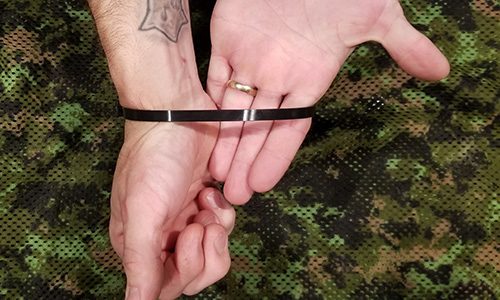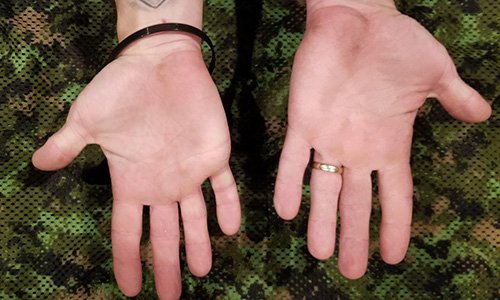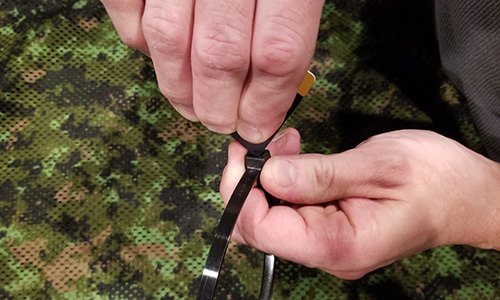While it is impossible that you will ever find yourself illegally detained with your hands secured by zip links, the risk exists, and learning how to free yourself is worthwhile.
Four methods that you can learn and use to avoid getting your hands tied by zip ties are illustrated in this article. I recommend you follow all these strategies because it’s much easier to recall how to do something you’ve done than to remember something in an article you read on your smartphone during your morning commute.
In the event of being lawfully arrested by law enforcement officers, the methods that I am about to mention should never be used. In that case, exercise your Miranda rights by complying with the law enforcement officer, remaining silent, and finding legal advice as soon as possible.
The Most Important Step
Your first move is to remain passive and present your hands in order to be bound if you find yourself facing inevitable unlawful detention. The first is that your captor may take your submissiveness as a sign that you will not try an escape, the second is that you will be able to decide how you will be tied. This achieves two purposes.
Present your hands to the left, not the back, to enable a simpler escape. Your captors are more likely to tie you in this way if you take the first move and keep your hands out in front of you instead of securing your hands behind your back.
Related: What Skills You Should Have For SHTF?
Slipping Out
Simply slipping your hands out of the zip tie is the best case scenario. Present your hands to the front, palms down, fists clenched and thumbs touching to make this sort of escape happen.


What this does is give you room between your wrists. When the zip tie is wound around your wrists and your fists are clenched, it will keep your wrists from being securely tied together.


All you need to do in this case is rotate your fists inward so that your palms touch, which will provide enough slack to slip your hands out.


Alternatively, you can present your hands with wrists stacked one on top of each other in an ‘X’.


Then when you want to escape you should be able to wiggle and slide the rest of your hand out.


Your goal here is to get one thumb out of the zip tie, allowing you to release the rest of your hand.


This approach is not near as easy as the previous one and may take a lot of work, but in most situations, it should be possible to do it.
Related: 23 Prepping Items that You Can Find at the Dollar Store
Breaking Out
If your captors know what they’re doing, they’ll want your palms and wrists close together when securing the zip tie. In this scenario, breaking the ratcheting mechanism within the head of the zip tie is one tool you can use. The process is broken down into steps:
Step One – Before removing your chains, make sure you have the next steps in your escape plan planned out.
Step Two – Try shifting the ratcheting mechanism between your wrists to a position that will make it easier to break. Also, get the palms of your hands facing each other which will make the maneuver that you are about to execute more effective.


Step Three – Using your teeth, tighten the zip tie around your wrists. It is important to get them as tight as you can.


Step Four – Raise your bound hands above your head. Take a deep breath and engage and tighten your core muscles.
Step Five – Bring your arms down in one quick and powerful motion, flaring out your elbows and bringing your bound wrists into your upper abdomen. DO NOT HESITATE! What you do is push your arms down and across your torso, and your arms will travel past your sides when they are freed from the zip tie if the zip tie breaks as expected. To get this strategy to work, you might need a few attempts.
Related: Top 10 Martial Arts for Self Defence


Step Six – Escape.


If your hands are bound to the rear using the same technique can work but is far more difficult to execute in the event of being bound to the rear you may have to attempt a modification of the friction saw which will be covered next.
Friction Saw
For a variety of reasons, you can fail at the above process. The zip ties may be a higher quality, or they may use police flex cuffs to bind your wrists. You may not have enough strength. If your hands are in front of you in both of these situations, you can use friction to break the zip tie.
This method allows your footwear laces to be used, but regular shoelaces are not nearly durable enough to be used as a friction saw. Substitute high-quality 550 cord or Kevlar cordage for the laces on your shoes or boots instead. To easily escape your bonds, then follow the following steps.
If you have footwear that has normal shoelaces, the friction saw will always strive to be decisive and aggressive in your technique execution. What will happen is that the shoelace may weaken the zip tie enough that the above technique will allow you to break it.
#1. Remove the laces of one of your shoes.
#2. Tie a slip knot or bowline loop on either end of the cord.
#3. Run the cord through the zip tie that you are planning to cut.
#4. Place one loop over each foot.
#5. Using a bicycling motion you want to use your legs to move the cord over one spot on the zip tie rapidly causing friction which will melt the plastic and break the tie.
If the hands are tied to the back, a modification of the friction saw will have to be used. Still tie two loops, but secure a solid object with one loop, and your foot with the other. Pull the cord taut and hopefully break it by running the zip tie back and forth over the cord.
Shimming
This technique is very hard to do on your bound wrists, but if you are kept hostage with other people, it is a good choice to free others so that they can free you in turn.
A plastic locking bar is within the head of the zip tie that keeps the teeth of the zip tie firmly in place. If you shim this locking bar away from the teeth the zip tie will loosen. You need a thin object to work between the locking bar and the teeth of the zip tie to do this.
The point tag end of the zip tie can often be used, but it can be more efficient to use fingernails, credit cards, handcuff shims, tiny screwdrivers, etc.
Related: The Best Folding Knife For Self-Defense?

Practice makes perfect
One thing is understanding these techniques, but having practiced them would be the difference between a fast, clean escape and a sloppy attempt to escape.
As a trust measure, the technique for breaking zip links should be mastered so that you not only realize that the technique works, but also have the confidence to not hesitate to use all of your strength and power to sever your bonds.
The technique of friction sawing is daunting because it is very difficult to tie knots with bound hands.
The chances of being abducted or detained illegally are extremely low, although there are countries where kidnapping is prevalent. Knowing how to escape from zip ties is an illegal detention insurance strategy and is something that is easy to learn and a worthwhile approach for children to learn because while abductions are uncommon, children are more likely to happen than adults.





















